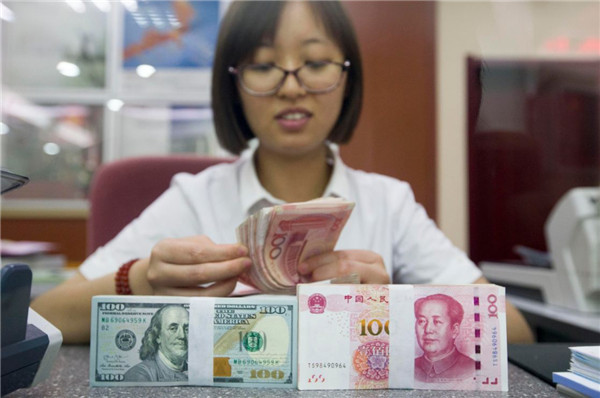More measures expected to stabilize RMB


An employee counts money at a bank in Taiyuan, capital of Shanxi province. [Photo/China News Service]
Experts believe authorities will further ease monetary policy to boost growth
To maintain a stable renminbi remains one of the key targets of the Chinese monetary policy, according to analysts, despite short-term fluctuations amid economic slowdown risks.
Additional measures, if necessary, will be taken to prevent risks in the foreign exchange market to stabilize domestic economic growth, they predicted.
The onshore renminbi spot exchange rate depreciated at one point to 6.9273 per US dollar on Monday, when the exchange rate market re-opened after a seven-day shutdown during the National Day holiday. That was a lowest level since Aug 16.
The offshore renminbi, which could float freely without a daily trading band like the onshore rate, weakened below 6.93 per dollar on Monday.
The weakness followed the central bank's unexpected cut of commercial banks' reserve requirement ratio to inject 750 billion yuan ($109 billion) into the financial sector, effective on Oct 15.
The central bank stressed that the move should not create additional depreciation pressure on the onshore renminbi. It will "continue to take measures, if necessary", to stabilize market expectations, said a statement on the People's Bank of China's website on Sunday.
"That means to keep a stable exchange rate remains one of the priorities of China's monetary policy," said Ming Ming, an analyst with CITIC Securities.
Jameel Ahmad, global head of currency strategy and market research at FXTM, a global foreign exchange trading platform, said the RRR cut, however, might have contributed to "a subdued investor atmosphere", because that might be seen by the markets as an indication that ongoing external uncertainties and other challenges are weighing on China's economic momentum.
For the Chinese currency, investors always anchor an important "psychological" exchange rate at 7 against the US dollar, and they worry that market panic may emerge if the renminbi weakens past that rate. Some market watchers expected that the monetary authority may take measures to hold renminbi above that level.
Other than to remain above a certain exchange rate, a more important matter is to develop a proper exchange rate regime, Liu Shijin, a member of the central bank's monetary policy committee, wrote in an article in Economic Daily.
Liu suggested that the exchange rate reform will continue toward a more flexible and market-oriented regime, and "the renminbi's equilibrium level is not fixed but dynamic".
Looking to the future, China still has various policy tools to deal with fluctuations of exchange rates, and keep the renminbi at a reasonable equilibrium level, supported by the country's sufficient foreign exchange reserves, Liu said.
Depreciation pressure on the renminbi has grown since mid-April, when the strength of the US dollar gathered pace. The onshore traded renminbi was 6.8814 per dollar by the end of September, having weakened by 5.4 percent compared with its value at the beginning of this year, according to data from the central bank.
"Given the authorities' focus on the broad stability of the onshore renminbi, we see a fairly steady onshore renminbi in the near term, though with a weakening tilt over a six-month horizon," said MK Tang, an economist with Goldman Sachs (Asia).
"We continue to believe the authorities will ease the monetary policy as needed to avoid a sharp slowdown in growth, with an infrastructure boost being a particularly key policy lever," he said.







